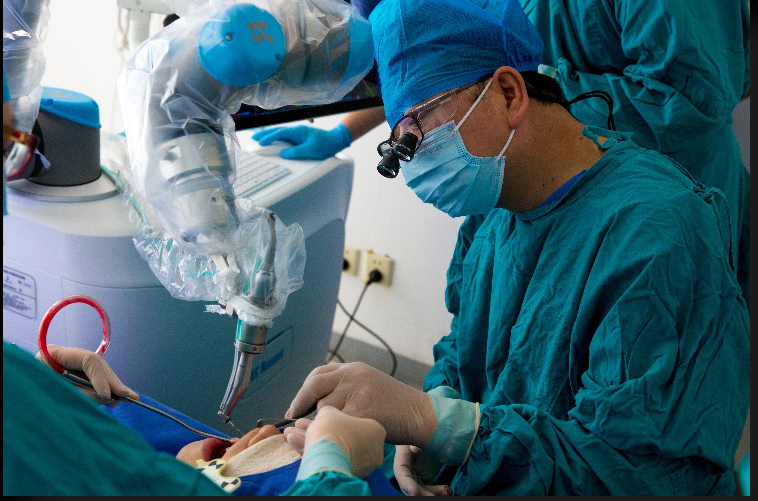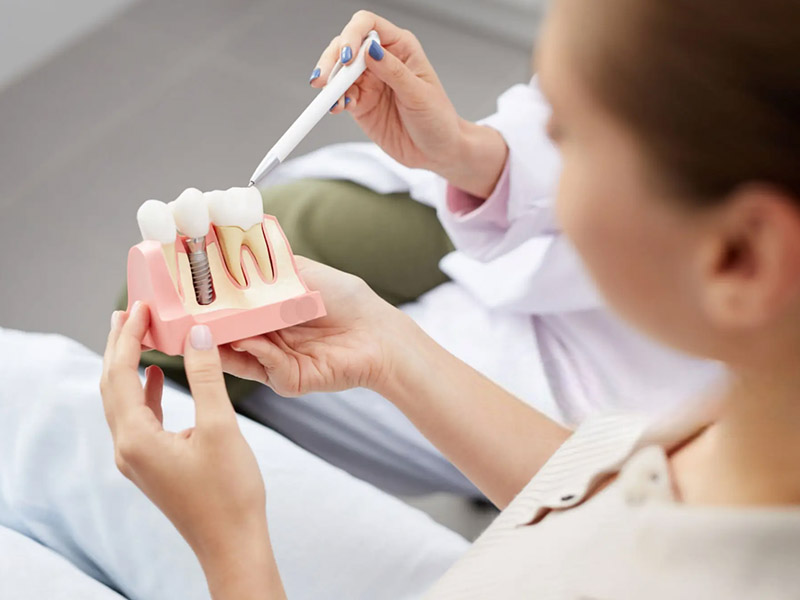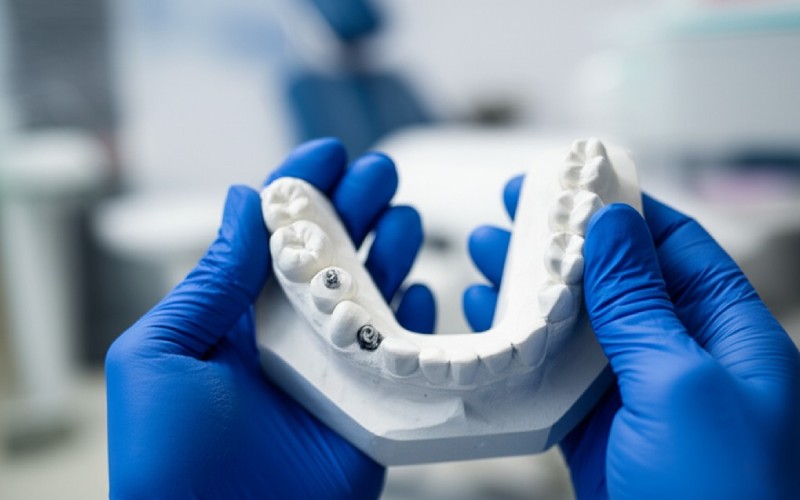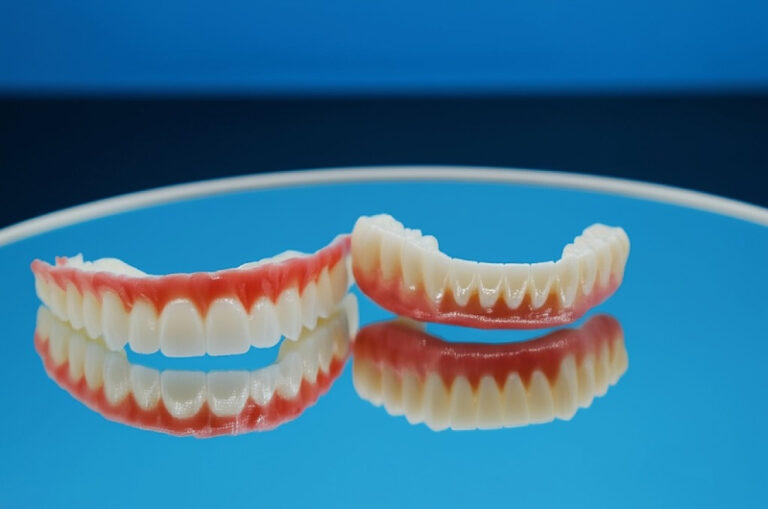
Dental Implant Surgery: Your Guide to the Implant Procedure
This post will walk you through the entire dental implant surgery from start to finish. I’ll explain what to expect, and why it would be one of the best decisions for your health. If you are facing the loss of a tooth, this article will help you understand your options and feel more confident.
Table of Contents
What is a Dental Implant, Really?
Dental implants are artificial tooth roots. Think of them as small, strong anchors for your new tooth. The implant itself is a small titanium screw that is surgically placed into your jawbone, right where your old tooth root used to be. This little metal post is the foundation for everything that comes later.
The reason this is so amazing is that the implant becomes part of you. Your bone grows around it, making it incredibly strong. Unlike a denture or bridgework that sits on top of your gums, an implant is a part of your jaw. This means the new tooth won’t slip or click when you talk or eat. These artificial tooth roots provide a strong base, allowing your new tooth to look and feel just like a real one. The entire goal is to create a replacement that feels like it has always been there. The implant is the key to that success.
Is Dental Implant Surgery the Right Choice for Me?
Not everyone is a good candidate for dental implant surgery. The most important factor is the health of your jawbone. You need to have enough strong bones to hold the implant securely. The dentist will take X-rays and a 3D scan to check the condition of your jawbone. He also checks the health of your gum tissue. Healthy gums are very important for the long-term success of the implant.
You also need to have good general oral health. If you have gum disease or a lot of tooth decay, your dentist will want to treat those problems first. A successful implant needs a healthy mouth to thrive in. The good news is that most people who are healthy enough for a routine tooth extraction are also healthy enough for this implant surgery. It’s a very common and safe procedure today, but your health is always the first priority.

Who Performs the Implant Surgery? An Oral Surgeon?
Does my regular dentist do the surgery? The answer is no, usually. Your dentist plans the new tooth, but he may refer you to a specialist for the implant surgery itself. There are several types of dental specialists who can place an implant. The most common is an oral and maxillofacial surgeon. An oral surgeon is a surgeon who has extra training in surgeries of the mouth, face, and jaw.
Another type of dental specialist is a periodontist. A periodontist focuses on the gums and the bone that supports the teeth. Since the implant is placed in the jawbone and surrounded by gum, they are also experts at this procedure. Don’t be afraid to ask about your surgeon’s training and experience with placing an implant.
What Happens During the First Implant Procedure?
The whole thing is an outpatient procedure, which means you go home the same day. First, they will give you anesthesia. Usually, you decide on local anesthesia, which just numbs your mouth, so you can be awake for the surgery but feel nothing. Some people might get general anesthesia if they are very anxious or having a more complex surgery. The type of anesthesia is something you’ll decide with your surgeon.
The surgeon then will make a small opening in your gum to expose the bone. He uses a special, quiet drill to create a space in your jawbone for the implant. It sounds scary, but honestly, you don’t feel it. He then carefully places the implant screw into the bone. This part is surprisingly quick. The last step is to close the gum tissue over the implant. An implant post is now in my jawbone, ready to heal. The whole dental implant surgery involves several steps, but the first one is the biggest. You will be given an antibiotic to help prevent infection.
What If My Jawbone Isn’t Strong Enough? The Bone Graft Explained.
This can happen after a tooth has been gone for a while. In this case, you need a bone graft to make sure the jawbone is strong enough to support the implant. A bone graft sounds serious, but it’s a very common part of dental implant surgery. The surgeon may do this at the same time he places the implant.
A bone graft uses special material to help your body create new bone growth. This material can come from another part of your body, a donor, or it can be a man-made material. The surgeon places it where more bone is needed. Your body then uses it as a scaffold to build enough new bone. This makes the site strong and solid. It takes a little extra time for this new bone to heal and become strong, but it’s a key step to make sure your implant lasts a lifetime.
How Long Does It Take for the Implant to Heal?
After the implant is placed, the most important part of the journey begins: healing. This is not like healing from a cut. A special process called osseointegration has to happen. Osseointegration is a big word that just means your jawbone is growing onto and fusing with the surface of the titanium implant. This is what makes the implant so strong. The bone will heal tightly around the implant, making it a permanent part of your jaw.
This amazing process can take some time. You have to be patient. For most people, it will take several months for the implant to fully bond with the jawbone. During this time, you won’t feel anything happening. You just live your life as normal. Your dentist will check on your progress to make sure everything is healing correctly around the implant. This waiting period is what allows the implant to become a solid anchor in your jawbone and serve as a reliable root for your new tooth.
What is an Abutment? When Will My Surgeon Place the Abutment?
The abutment is a small connector piece. It screws into the top of the implant and sticks out just above the gumline. It’s the part that will eventually hold my new tooth. This is a much smaller procedure than the first implant surgery.
To place the implant abutment, the surgeon will give you a little local anesthetic to numb the area. He then makes a tiny opening in your gum tissue to uncover the implant. He attached the abutment and tightened it into place. Then, the gum is allowed to heal around the abutment. This creates a nice, clean collar of tissue that looks very natural. This part of the process only takes a week or two to heal completely. Then, you will have a little metal post ready and waiting for your final tooth.

How Are the New Artificial Teeth Made?
With the abutment in place, you will finally be ready for your new tooth. Go back to your regular dentist for this step. First, he takes new impressions of your mouth. These impressions are used to make a perfect model of your teeth and the abutment. The dentist uses this model to create one of the new artificial teeth that would match your other teeth perfectly in size, shape, and color.
A special dental lab will make your final crown, which is the part that looks like a tooth. When it’s ready, you need to go back to my dentist. He checks the fit and the color one last time. Then, he uses a strong dental cement to attach the artificial tooth to the abutment. The new tooth will be now permanently attached to the implant. It feels solid and looks amazing.
What If I Need a Full Implant Denture?
What if you are missing several teeth or even many teeth? The good news is that dental implants can help with that, too. You don’t always need one implant for every single missing tooth. Your surgeon can place a few implants that can support a bridge or a special type of denture. This is often called a full implant or full mouth dental restoration.
For example, a denture can be placed on top of two or more implants. This type of denture is often mounted on a metal frame. It can be a removable denture that you can snap on and off the implants for easy cleaning. Or, it can be a piece of permanent bridgework that is screwed firmly in place by your dentist. These options are much more stable and comfortable than a traditional denture that just rests on your gums.
How Do I Take Care of My New Dental Implants?
The journey doesn’t end when the new tooth is in place. For long-term success, you have to take good care of your dental implants. The great news is that it’s easy. You care for them just like natural teeth. You need to brush and floss every day. The implant crown itself can’t get decay like a natural tooth, but you still have to keep your gums healthy around the dental implant.
Your dentist will show you how to use a special interdental brush to clean around the implant and abutment. Good oral hygiene is the best way to make sure your implant lasts a lifetime. With proper care, dental implants require very little maintenance and will likely never need to be replaced. They look and feel so much like real ones, you might even forget which tooth is the implant! See your dentist for regular checkups to make sure your implant and your overall oral health stay in great shape.




